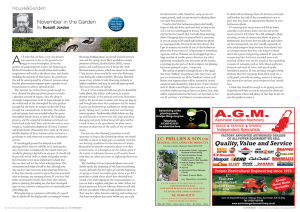
As I write this, it’s been a very wet descent into autumn so far, so the ground is too soggy to even contemplate all but the gentlest of gardening tasks. Leaves are beginning to fall but November is the month when much colder temperatures will result in deciduous trees and shrubs shedding the majority of their leaves. In a good year this will be accompanied by a blaze of autumn colour but this phenomenon requires quite a specific set of circumstances to achieve optimal results.
The summer has to have been good enough to have allowed the photosynthesis process to make a plentiful amount of sugars. Also, the drop in overnight temperatures must be large enough to start the withdrawal of the chlorophyll but also gradual enough for the leaves to remain on the trees long enough for autumnal tints to develop. The yellow, red and orange hues are revealed when the green chlorophyll breaks down, as part of the shedding process, and the colourful breakdown chemicals are left behind in the leaf. Trees and shrubs such as acers (maples), Liquidambar, dogwoods (Cornus), Euonymus and witch-hazels (Hamamelis) have some of the most reliable displays of fiery autumn colour so now is a good time to seek them out in nurseries and garden centres.
If waterlogged ground has delayed your bulb planting efforts then it’s still OK to be finishing this now; November is traditionally the month when you should be planting tulip bulbs in any case. It should still be possible to buy bulbs in shops and garden centres but it becomes even more important to check that they are firm and rot free when selecting them. The aforementioned tulips should be fine although you may need to take extra care, when planting them out, if they have already started to sprout because you don’t want to damage any emerging shoots. If you have had bulbs sat around for weeks then check them closely, prior to planting, discarding any that have developed signs of rot, excessive moisture loss or ‘mummification’ (shrivelling up).
When planting up containers with bulbs it’s a good idea to finish off the display with a covering of winter flowering bedding plants to provide interest between now and the spring. Some likely candidates include primroses (Primula), double daisies (Bellis), winter pansies and small-leaved ivies. I favour the small flowered winter pansies, which are closer to the native Viola, because these tend to be more free flowering even during the coldest weather. The large flowered pansies have a habit of only flowering profusely in milder conditions and may sit and sulk right up until they sense the onset of spring!
Even if it has remained mild enough for doubtfully hardy plants, like dahlias and cannas, to remain planted outside, in the ground, until now, November really is the last chance to make sure these are dug up and brought into frost-free conditions for the winter. Cannas can be potted up and kept just barely moist, gently ‘ticking over’, in their cool, but not freezing, winter quarters. Traditionally, dahlia tubers are dug up and cleaned, to remove wet soil, slugs and other damaging soil pests, before being left upturned for a week or two, in the greenhouse, to allow excess moisture to drain out of the necks of the severed stems.
I’m not sure this ‘draining’ procedure is really necessary as long as the cleaned up tubers are stored carefully, in crates or large pots, in similarly ‘cool but not freezing’ conditions for the duration of winter. Remember to label the respective plants with their correct name, or a description of the mature plant if the variety is unknown, because you’ll need to know what they are when you come to replanting them next spring.
The shedding of leaves from deciduous trees and shrubs marks the beginning of the bare-root planting season, although this lasts right up until the beginning of spring so there’s no need to panic about it yet. It’s a good idea to think about what’s best obtained bare-rooted, trees and hedging are the usual candidates, so you can find a supplier, and place an order, before any choice specimens become sold out. Growers will only lift bare-root plants when ground conditions allow so there may be a delay between ordering and sending out. Any bare-root plants that arrive before you are ready for them can be safely ‘heeled in’, using an area of empty ground, until you get around to planting them into their final positions.
I tend to find that herbaceous plants don’t really begin to fully die down until now and, as long as the soil is not too waterlogged or frozen, November may be the first month that I actually chop anything down. Chopping down to ground level is necessary if you are going to lift and divide herbaceous plants so, consequentially, this may be the first chance that I get to increase my stocks of any of the herbaceous plants that I want more of. A big clump of something vigorous, such as Helenium, can be chopped up into a large number of smaller pieces, divisions, for either replanting immediately, into new parts of the border, or potting up, into pots of fresh compost, for planting later next spring or to give / swap away.
The arrival of proper overnight frosts is the signal that most ‘fiddling’ maintenance jobs must cease and you can concentrate on all the ‘hardcore’ winter stuff. Before that happens there will be a period of crucial autumnal tasks dictated by fallen leaves. A lawn mower, with it’s blades raised higher than normal, can be used to collect a light covering of leaves, on lawns, but a rake will be required wherever the leaves are too thick or too wet. If you have a leaf blower, a certain amount can be dealt with by blowing them off the lawn, into beds and borders, but only if the accumulation is not so great that they form an impenetrable blanket on your herbaceous plants.
It’s amazing how many leaves will break down naturally, or get drawn down into the top soil by worm action if left where they fall, although a thick covering, on top of ornamental plants or grass, is detrimental. Any leaves that you rake up and collect are best composted, into leaf mould, separately to your usual compost heap because their relative lack of nitrogen means that they take longer to break down than green composting material. If you make composting bins for leaves, rounded posts with attached chicken wire are the simplest, then sprinkling a source of nitrogen, such as ‘fish, blood and bone’, between each layer of leaves will speed up the breakdown process. If you are lucky enough to keep chickens then the sweepings from their coup are a really good, naturally occurring, source of nitrogen rich material to activate your compost or leaf mould bins.
I think that should be enough to be getting on with. Hopefully we’ll have an end to autumn that allows for good autumn colour and plenty of fine days to get out into the garden to enjoy it.



